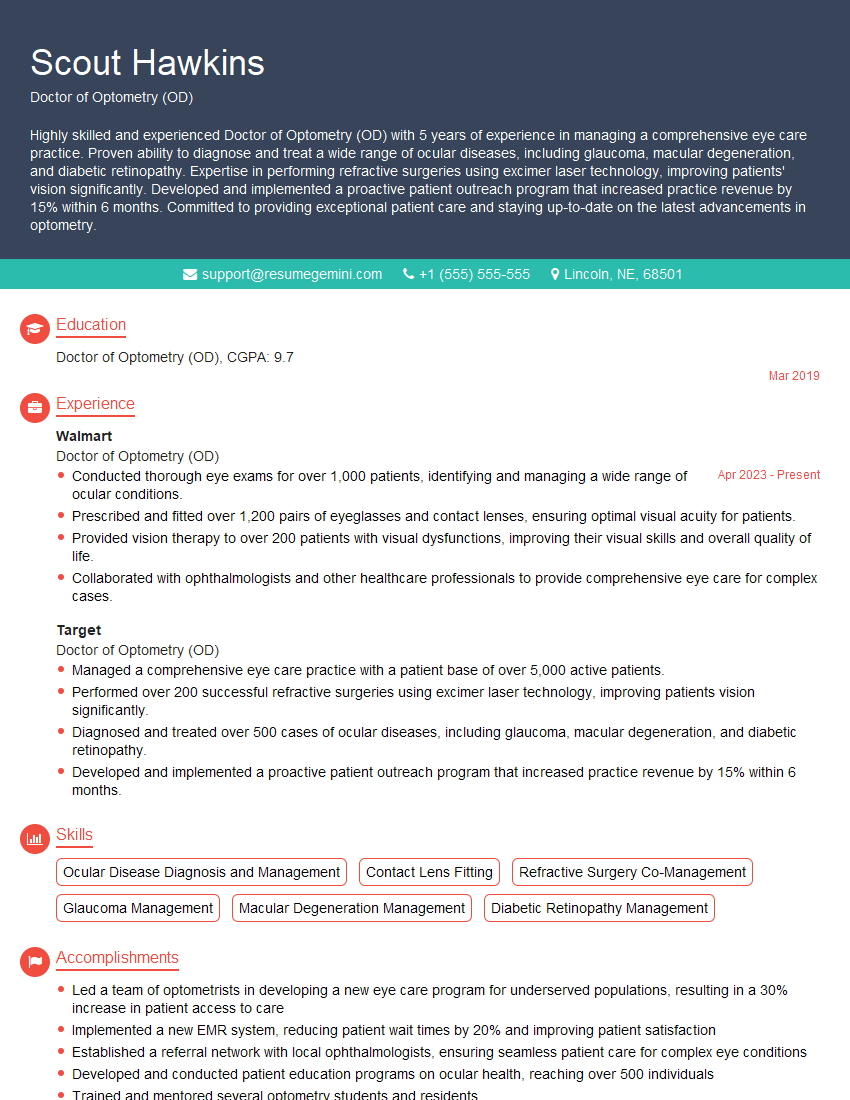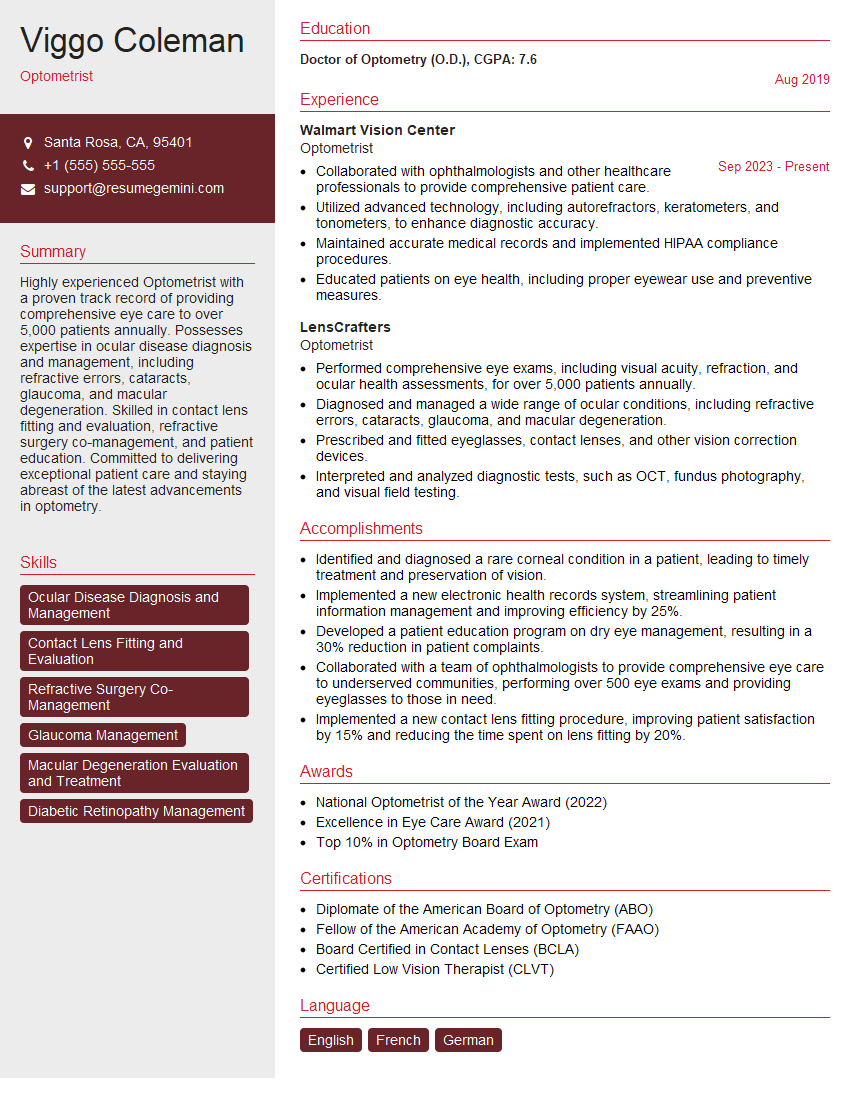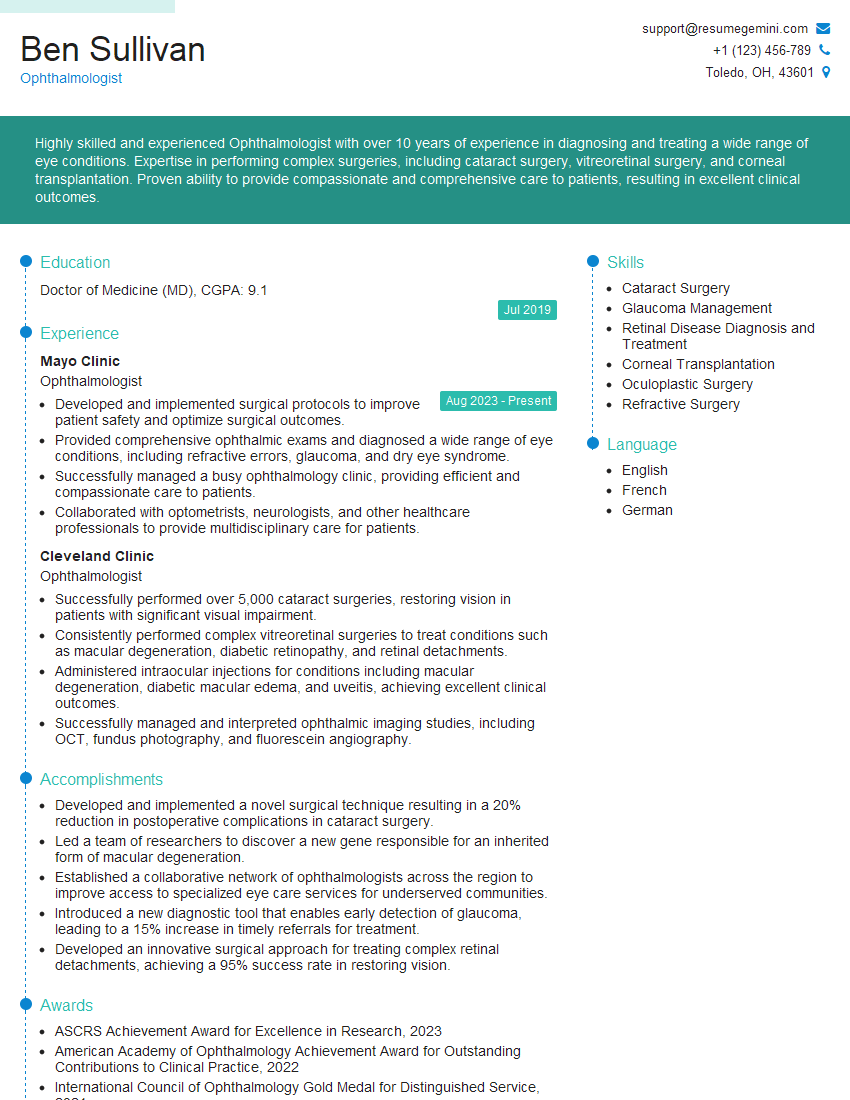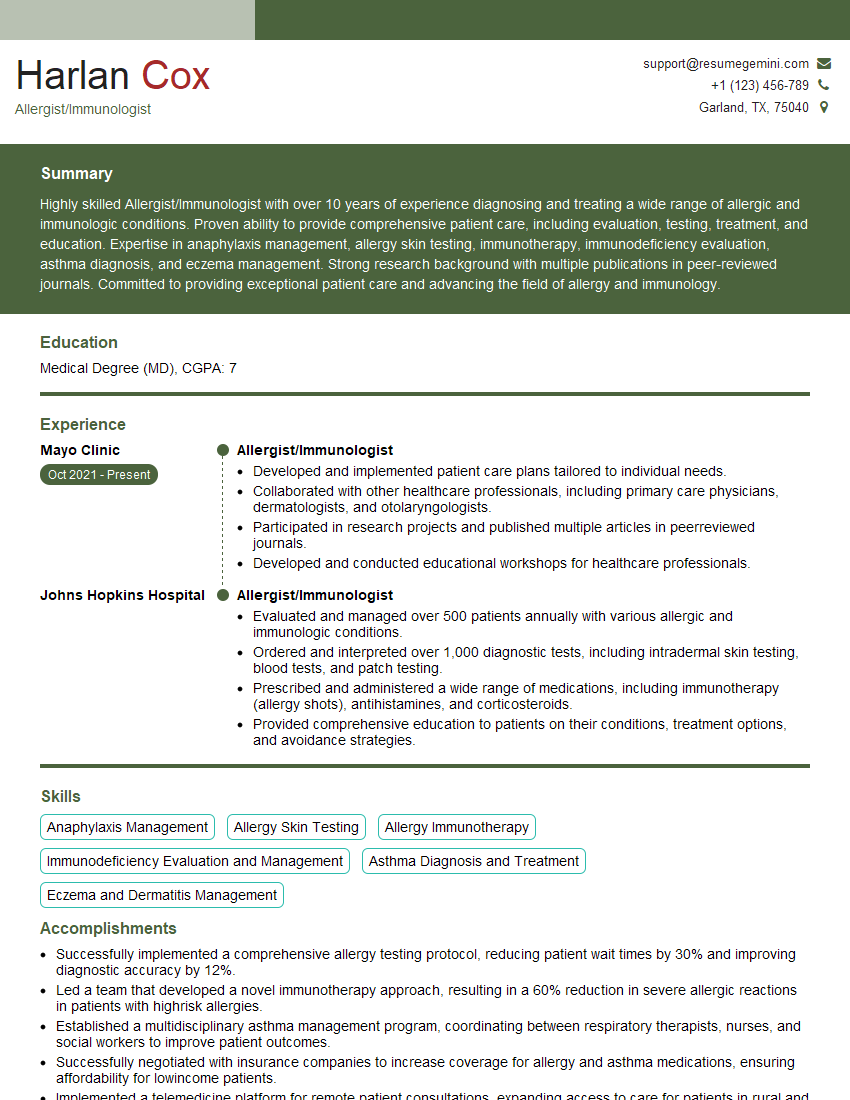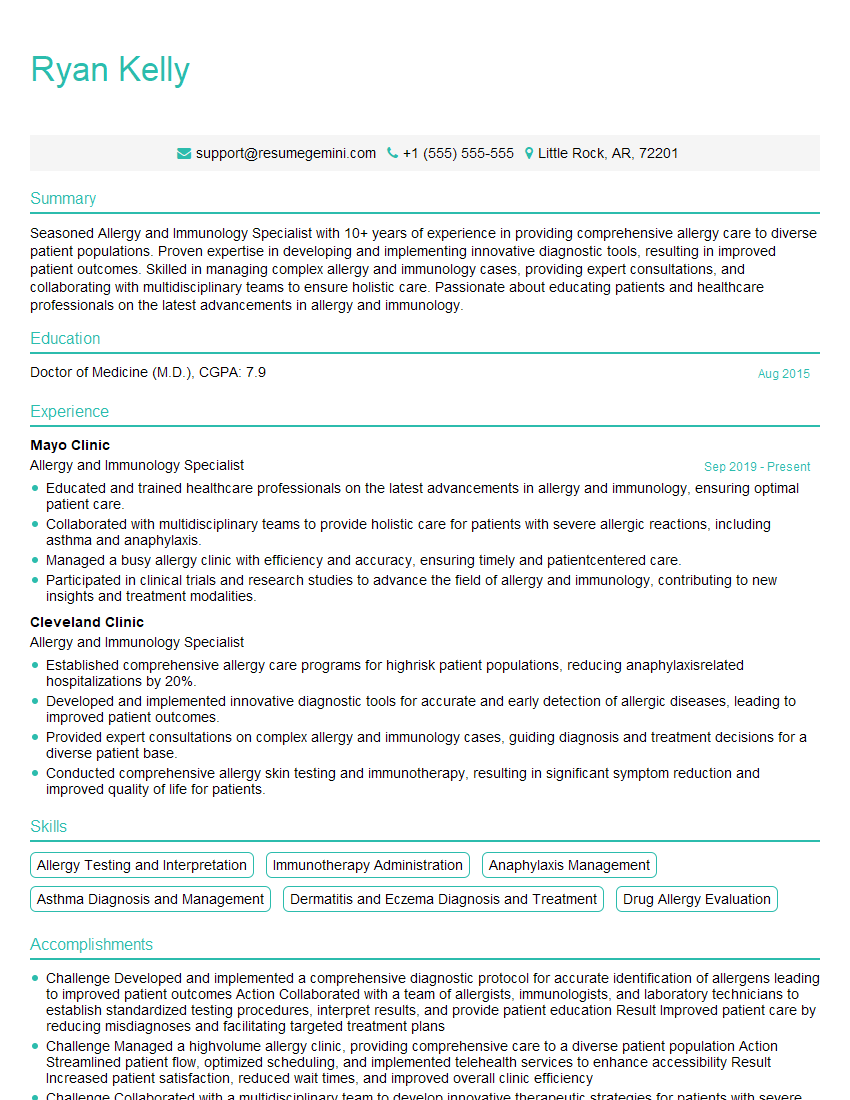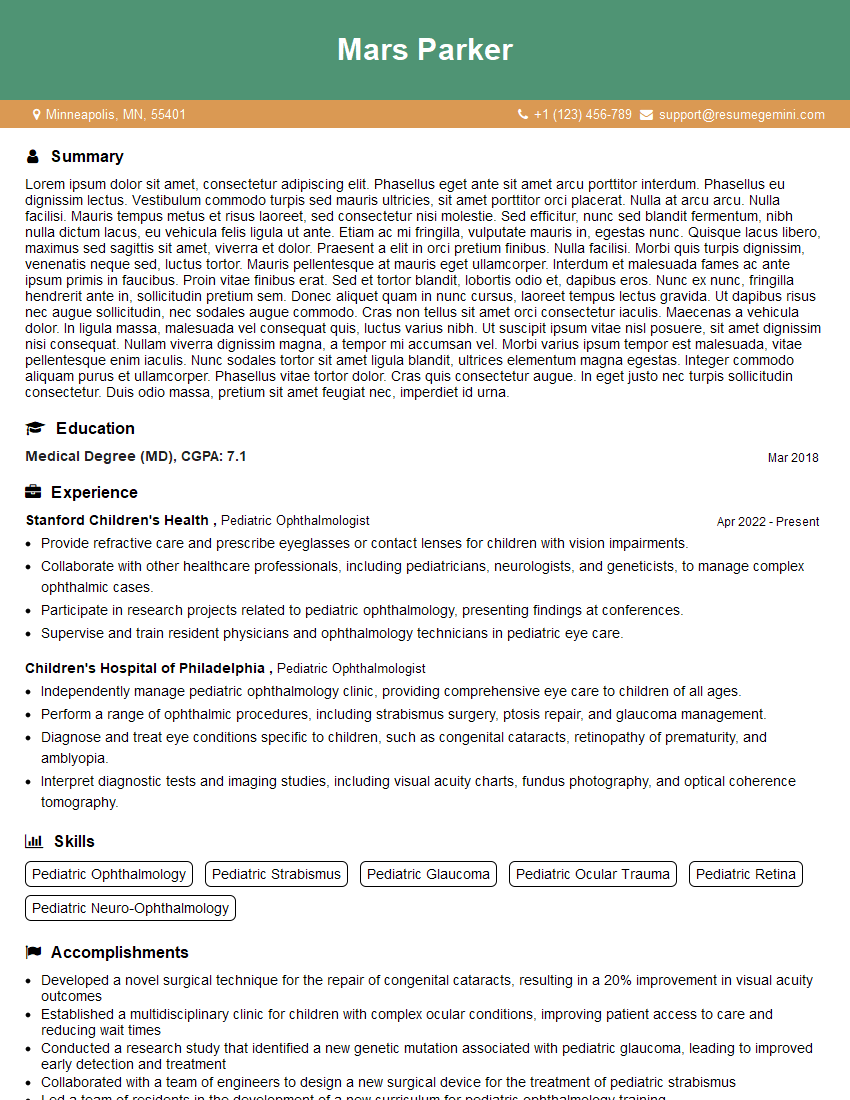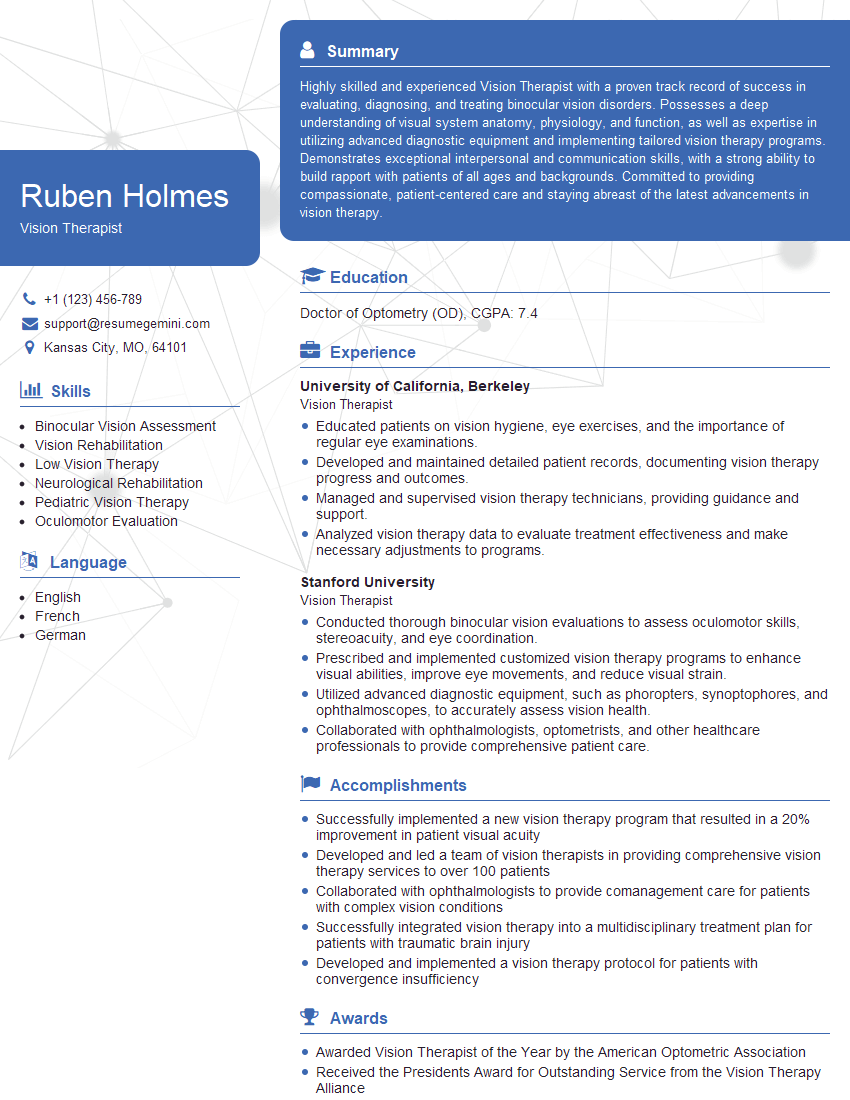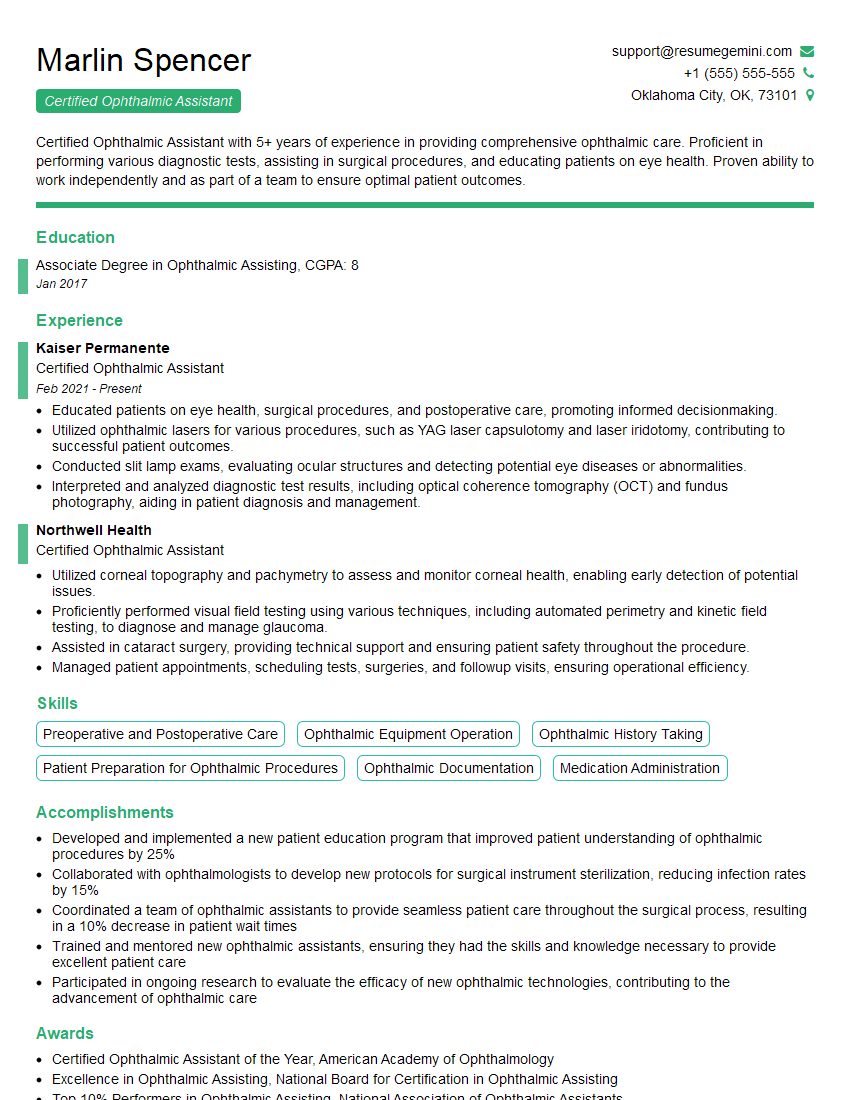The right preparation can turn an interview into an opportunity to showcase your expertise. This guide to Allergic Conjunctivitis Management interview questions is your ultimate resource, providing key insights and tips to help you ace your responses and stand out as a top candidate.
Questions Asked in Allergic Conjunctivitis Management Interview
Q 1. Explain the pathophysiology of allergic conjunctivitis.
Allergic conjunctivitis, or allergic eye inflammation, arises from an immune response to allergens. When allergens like pollen, dust mites, or pet dander contact the conjunctiva (the membrane lining the eyelids and covering the sclera), they trigger a cascade of events. This involves mast cells in the conjunctiva releasing inflammatory mediators like histamine, leukotrienes, and prostaglandins. These mediators cause the characteristic symptoms of allergic conjunctivitis.
Think of it like this: your eye’s immune system mistakenly identifies a harmless substance (the allergen) as a threat. It then overreacts, causing inflammation and the subsequent symptoms. The process involves several steps: sensitization (initial exposure), allergen binding to IgE antibodies on mast cells, mast cell degranulation releasing inflammatory mediators, and finally, the inflammatory response causing ocular symptoms.
Q 2. Differentiate between allergic and infectious conjunctivitis.
The key difference between allergic and infectious conjunctivitis lies in their underlying cause. Allergic conjunctivitis is an immune response to allergens, while infectious conjunctivitis is caused by a pathogen, such as bacteria, viruses, or fungi. This distinction significantly impacts treatment.
- Allergic Conjunctivitis: Itching is a hallmark symptom, often accompanied by watery discharge, and is typically bilateral (affecting both eyes). There’s usually no significant pus or crusting.
- Infectious Conjunctivitis: This often presents with a more purulent (pus-like) discharge, potentially accompanied by redness, swelling, and crusting, and may be unilateral (affecting one eye) initially. Itching is less prominent than in allergic conjunctivitis.
For example, someone with pollen allergies will experience itchy, watery eyes during allergy season, a classic allergic conjunctivitis. In contrast, a child with ‘pinkeye’ (often viral conjunctivitis) will have more of a sticky, potentially purulent discharge, with less pronounced itching.
Q 3. Describe the common symptoms of allergic conjunctivitis.
Common symptoms of allergic conjunctivitis include itching, watery eyes, redness (hyperemia), and swelling of the conjunctiva (chemosis). Patients may also experience burning, a gritty sensation (feeling like something is in the eye), and light sensitivity (photophobia). In severe cases, there might be significant eyelid swelling.
Imagine the feeling of intense itchiness and the constant urge to rub your eyes. This is often accompanied by a significant tearing response, leading to blurry vision and discomfort. The redness is prominent, making the eyes appear bloodshot. These symptoms can disrupt daily activities and sleep.
Q 4. What are the different types of allergic conjunctivitis?
Allergic conjunctivitis is categorized into several types based on the duration and nature of the allergic response.
- Seasonal allergic conjunctivitis (SAC): This is triggered by seasonal allergens like pollen, typically appearing during specific times of the year, such as spring or fall.
- Perennial allergic conjunctivitis (PAC): This occurs year-round, due to exposure to persistent allergens such as dust mites, pet dander, or mold spores.
- Giant papillary conjunctivitis (GPC): This is a specific type often associated with contact lens wear or eyelid irritation from foreign bodies. It involves the formation of large papillae on the conjunctiva.
Understanding the type helps tailor treatment strategies. For instance, seasonal allergies might benefit from allergen avoidance during peak seasons, while perennial allergies might require ongoing management with medications.
Q 5. How do you diagnose allergic conjunctivitis?
Diagnosis of allergic conjunctivitis primarily relies on a thorough clinical examination and patient history. This involves assessing the patient’s symptoms, the timing of symptom onset (seasonal versus perennial), the presence of other allergic conditions (e.g., rhinitis, asthma), and a review of potential allergen exposure.
A detailed history, for example, might reveal that a patient experiences intense eye itching and watery eyes every spring when the oak trees are blooming. This strongly suggests seasonal allergic conjunctivitis. The physical examination focuses on assessing the characteristic signs like conjunctival redness, swelling, and the presence of papillae (small bumps) on the conjunctiva.
Q 6. Discuss the diagnostic tests used to confirm allergic conjunctivitis.
While a clinical examination is usually sufficient for diagnosis, some cases may benefit from further testing to confirm the allergen responsible or rule out other conditions.
- Allergy skin testing: This involves pricking the skin with extracts of potential allergens to check for a wheal-and-flare reaction (a raised, itchy bump) indicating an allergic response. This helps identify the specific allergen triggering the reaction.
- Serum-specific IgE testing: Blood tests measure the level of IgE antibodies specific to different allergens. High levels of IgE to certain allergens support the diagnosis and helps in identifying the causative agent.
These tests are particularly useful in cases where the clinical picture isn’t entirely clear or when determining specific allergen avoidance strategies.
Q 7. What are the first-line treatment options for allergic conjunctivitis?
First-line treatment for allergic conjunctivitis focuses on symptom relief and involves several approaches.
- Artificial tears: These help to lubricate the eyes, flush out allergens, and alleviate dryness and irritation.
- Topical antihistamines: These medications, like olopatadine or azelastine, block the action of histamine, reducing itching and inflammation.
- Topical mast cell stabilizers: These agents, such as cromolyn sodium or nedocromil sodium, prevent the release of inflammatory mediators from mast cells, thereby offering long-term control of symptoms.
- Topical nonsteroidal anti-inflammatory drugs (NSAIDs): These drugs, like ketorolac, can reduce inflammation and pain.
The choice of medication depends on the severity of the symptoms and the individual patient’s response. Often a combination of treatments provides optimal symptom control. For example, a patient with moderate symptoms might benefit from using artificial tears alongside a topical antihistamine.
In addition to medication, environmental control is crucial. This involves identifying and minimizing exposure to allergens through strategies like using air purifiers, regular cleaning, and avoiding known triggers.
Q 8. Describe the role of antihistamines in managing allergic conjunctivitis.
Antihistamines are a cornerstone of allergic conjunctivitis treatment. They work by blocking the action of histamine, a chemical released by mast cells during an allergic reaction. Histamine is the primary culprit behind the itching, redness, and swelling characteristic of allergic conjunctivitis. Antihistamines effectively reduce these symptoms.
There are two main types relevant to allergic conjunctivitis: oral antihistamines (like cetirizine or fexofenadine) and topical antihistamines (like azelastine or levocabastine). Topical formulations are generally preferred for allergic conjunctivitis as they target the eye directly, minimizing systemic side effects. Oral antihistamines can be helpful for more severe cases or when symptoms affect other parts of the body, like the nose.
For example, a patient presenting with significant itching and watery eyes might benefit from a topical antihistamine eye drop four times daily. If their symptoms are severe, or they also have significant nasal congestion, an oral antihistamine might be added to their treatment plan.
Q 9. Explain the use of mast cell stabilizers in treating allergic conjunctivitis.
Mast cell stabilizers prevent the release of histamine and other inflammatory mediators from mast cells. This action differs from antihistamines, which block the *effects* of histamine after its release. Mast cell stabilizers are particularly useful in preventing allergic reactions, making them a good choice for patients with frequent or prolonged allergic conjunctivitis episodes.
Common mast cell stabilizers used for allergic conjunctivitis include cromolyn sodium and nedocromil sodium. These are typically applied as eye drops multiple times a day. They are often less effective at treating *acute* symptoms than antihistamines, but they are excellent for long-term prophylaxis. Imagine it like this: antihistamines are like putting out a fire (treating the symptoms), while mast cell stabilizers are like preventing the fire from starting in the first place (preventing the release of inflammatory mediators).
A patient with seasonal allergic conjunctivitis might start using a mast cell stabilizer eye drop several weeks before the pollen season begins to help minimize their symptoms during the peak allergy season.
Q 10. What are the potential side effects of common allergic conjunctivitis medications?
While generally well-tolerated, allergic conjunctivitis medications can cause side effects. Topical antihistamines can sometimes cause a mild burning or stinging sensation upon application, temporary blurry vision, or dryness. Oral antihistamines can lead to drowsiness, dry mouth, or constipation, particularly with older, more sedating antihistamines. Mast cell stabilizers are usually well-tolerated, but some individuals may experience a mild stinging sensation.
It’s crucial to obtain a thorough medication history from patients, especially those with pre-existing conditions like glaucoma or dry eye disease, to minimize the risk of adverse reactions. For example, if a patient already experiences dry eyes, a topical medication that could further exacerbate dryness should be avoided or used cautiously, and a lubricating eye drop might be recommended concurrently.
Q 11. Discuss the management of severe allergic conjunctivitis.
Severe allergic conjunctivitis requires a more aggressive approach. This often involves a combination of therapies, including high-dose topical antihistamines and mast cell stabilizers, potentially combined with topical corticosteroids. Corticosteroids are potent anti-inflammatory agents, but their prolonged use can carry significant side effects like glaucoma and cataracts. Therefore, they are typically reserved for short-term use in severe cases or when other treatments have failed.
In severe cases, referral to an ophthalmologist is warranted to consider additional interventions, such as allergen-specific immunotherapy, or to rule out other causes of conjunctivitis. A patient with significant periorbital edema (swelling around the eyes) or difficulty opening their eyes due to severe inflammation would require immediate attention and likely corticosteroid treatment.
Q 12. When would you refer a patient with allergic conjunctivitis to a specialist?
Referral to an ophthalmologist or allergist is appropriate when allergic conjunctivitis is unresponsive to standard treatment, particularly if there are complications or suspicion of other conditions. Referral is also indicated for severe cases, as mentioned above, and when there is any suspicion of a more serious underlying condition such as giant papillary conjunctivitis (GPC), which is a specific form of allergic conjunctivitis often associated with contact lens wear.
For instance, a patient with persistent symptoms despite using combination therapy for several weeks, or one experiencing significant visual impairment or discomfort should be referred immediately. Similarly, any atypical presentation or presence of concurrent symptoms warrant specialist consultation.
Q 13. Explain the role of allergen avoidance in managing allergic conjunctivitis.
Allergen avoidance is crucial for managing allergic conjunctivitis, especially in preventing future episodes. This involves identifying and minimizing exposure to specific allergens triggering the reaction. Common allergens include pollen, pet dander, dust mites, and molds.
Strategies for allergen avoidance can include staying indoors during peak pollen hours, using air purifiers with HEPA filters to remove airborne allergens, regularly washing bedding in hot water to kill dust mites, and keeping pets out of the bedroom. A detailed discussion with the patient about their environment and potential triggers is vital in developing an effective avoidance plan. In some cases, allergy testing can be helpful to pinpoint specific allergens to target for avoidance.
Q 14. How do you counsel patients on preventing future allergic conjunctivitis episodes?
Patient counseling is essential for long-term management of allergic conjunctivitis. This includes educating patients about their specific triggers, explaining how the medications work, and emphasizing the importance of adherence to treatment plans. In addition to medication, I always emphasize the role of allergen avoidance strategies, regular hygiene practices (like handwashing), and the importance of using lubricating eye drops, especially if using other eye medications which may cause dryness.
For instance, I would provide patients with a written plan outlining their medications, avoidance strategies, and when to seek medical attention. I’d also empower them to actively participate in identifying and managing their own triggers. This collaborative approach ensures that patients understand their condition and feel equipped to minimize future episodes.
Q 15. Describe the use of cold compresses in managing allergic conjunctivitis.
Cold compresses are a simple yet effective first-line treatment for the discomfort associated with allergic conjunctivitis. The coolness helps constrict blood vessels, reducing swelling and inflammation in the conjunctiva (the membrane lining the inside of the eyelid and covering the white part of the eye). This leads to a decrease in itching and redness.
To use cold compresses effectively, soak a clean cloth in cool (not icy) water, wring out excess water, and gently apply it to the affected eye(s) for 10-15 minutes at a time, several times a day. This can provide significant relief, especially during acute flare-ups. Remember to use a clean cloth each time to avoid introducing infection.
Think of it like icing a sprained ankle – the cold helps soothe the inflammation and reduce pain. However, unlike a sprained ankle, cold compresses alone won’t cure allergic conjunctivitis; they’re best used in conjunction with other treatments.
Career Expert Tips:
- Ace those interviews! Prepare effectively by reviewing the Top 50 Most Common Interview Questions on ResumeGemini.
- Navigate your job search with confidence! Explore a wide range of Career Tips on ResumeGemini. Learn about common challenges and recommendations to overcome them.
- Craft the perfect resume! Master the Art of Resume Writing with ResumeGemini’s guide. Showcase your unique qualifications and achievements effectively.
- Don’t miss out on holiday savings! Build your dream resume with ResumeGemini’s ATS optimized templates.
Q 16. Discuss the role of artificial tears in managing allergic conjunctivitis.
Artificial tears play a crucial role in managing allergic conjunctivitis by lubricating and stabilizing the tear film. In allergic conjunctivitis, the eyes often produce insufficient or poor-quality tears, leading to dryness, irritation, and increased itching. Artificial tears replenish this moisture, washing away allergens and irritants that further exacerbate the condition.
They are particularly useful for mild cases or as an adjunctive therapy alongside other medications. Different formulations are available, including those with preservatives and preservative-free options. Preservative-free are generally preferred for frequent use, as preservatives can sometimes cause irritation themselves. It’s important to choose a formulation that the patient tolerates well and that suits their individual needs and frequency of use.
Imagine your eyes as a delicate machine. Artificial tears act as the lubricant, keeping everything moving smoothly and preventing friction and irritation, offering immediate relief from dryness and discomfort.
Q 17. What are the potential complications of untreated allergic conjunctivitis?
Untreated allergic conjunctivitis can lead to several complications, ranging from minor inconveniences to significant long-term issues. Persistent inflammation can cause chronic dryness, leading to damage of the cornea (the clear front part of the eye) and potentially impairing vision.
Furthermore, intense itching can lead to rubbing the eyes excessively, potentially resulting in corneal abrasions or even secondary bacterial infections. In some cases, untreated allergic conjunctivitis can progress to more severe conditions, such as keratitis (inflammation of the cornea), which can cause significant vision problems if not managed promptly.
Moreover, the chronic inflammation and irritation can impact quality of life, affecting sleep, work productivity, and overall well-being. Thus, prompt and appropriate treatment is crucial to prevent these complications.
- Corneal damage: Leading to impaired vision.
- Secondary infections: Due to excessive rubbing of the eyes.
- Keratitis: Inflammation of the cornea, potentially causing vision problems.
- Reduced quality of life: Affecting sleep, work, and overall well-being.
Q 18. How do you differentiate between seasonal and perennial allergic conjunctivitis?
The key difference between seasonal and perennial allergic conjunctivitis lies in the duration and timing of symptoms. Seasonal allergic conjunctivitis, as the name suggests, is associated with exposure to seasonal allergens like pollen, typically occurring during specific times of the year (e.g., spring for tree pollen, summer for grass pollen). Symptoms generally improve or resolve once the allergen season ends.
Perennial allergic conjunctivitis, on the other hand, persists year-round due to exposure to indoor allergens such as dust mites, pet dander, or mold. Symptoms are continuous and less influenced by seasonal changes. A detailed history of symptom onset, duration, and potential triggers is crucial for accurate diagnosis.
Imagine seasonal allergies like a predictable visitor – they arrive at the same time each year and then leave, while perennial allergies are like constant houseguests – always present and requiring ongoing management.
Q 19. Describe the use of topical corticosteroids in allergic conjunctivitis.
Topical corticosteroids are potent anti-inflammatory medications often used to manage moderate to severe allergic conjunctivitis. They effectively reduce inflammation, itching, and redness by suppressing the immune response that triggers the allergic reaction. These are usually applied as eye drops several times a day, according to the prescription provided by an ophthalmologist or allergist.
However, due to their potent effects, they’re typically reserved for cases that don’t respond adequately to other treatments, such as artificial tears and antihistamines. The duration of treatment is limited to prevent side effects, usually for a short period. The ophthalmologist will carefully monitor the patient for any adverse reactions during treatment.
Think of corticosteroids as powerful tools in your arsenal – incredibly effective, but they need to be used cautiously and under medical supervision due to potential side effects.
Q 20. What are the contraindications for using topical corticosteroids in allergic conjunctivitis?
Several contraindications exist for using topical corticosteroids in allergic conjunctivitis. These include patients with active or suspected viral or fungal infections of the eye, as corticosteroids can worsen these conditions. Patients with glaucoma or cataracts should also use caution, as corticosteroids can exacerbate these conditions.
Furthermore, prolonged use of topical corticosteroids can lead to side effects such as increased intraocular pressure (IOP), the development of cataracts, thinning of the cornea, and even glaucoma. Therefore, careful monitoring and short courses of treatment are crucial. In children, the use of topical corticosteroids should be strictly monitored due to potential systemic absorption.
It’s essential to have a thorough discussion with the eye care professional about the benefits and risks before starting topical corticosteroid treatment.
Q 21. How do you manage allergic conjunctivitis in patients with contact lenses?
Managing allergic conjunctivitis in contact lens wearers requires a multi-pronged approach. The first step is to discontinue contact lens wear until symptoms improve significantly. Contact lenses can trap allergens against the eye, exacerbating the inflammation. Regular cleaning and disinfection of contact lenses is crucial to remove allergens, but this alone may not be sufficient during an acute flare-up.
Treatment often involves a combination of artificial tears, antihistamine eye drops, and possibly mast cell stabilizers to reduce inflammation. Topical corticosteroids may be considered under close medical supervision, but their use should be carefully weighed against potential risks. Once symptoms subside and the eye is healthy, the patient can gradually resume contact lens use.
Regular eye exams are vital to ensure there is no corneal damage or infection related to lens wear during allergic flare-ups. Consider switching to daily disposable lenses to minimize the risk of allergen accumulation.
Q 22. What are the common allergens that trigger allergic conjunctivitis?
Allergic conjunctivitis, or allergic eye inflammation, is triggered by a wide range of allergens that come into contact with the eye’s surface. The most common culprits are airborne allergens such as pollen (tree, grass, weed), dust mites, pet dander (animal saliva, skin flakes), and mold spores. Other allergens include contact allergens like cosmetics, eye drops, and certain medications. Think of it like this: your eyes are constantly exposed to the environment, and if they encounter something your immune system identifies as a threat, an allergic reaction can occur.
- Pollen: Seasonal allergies are often dominated by pollen, causing a significant increase in allergic conjunctivitis cases during specific times of the year.
- Dust Mites: These microscopic creatures live in bedding, carpets, and upholstery, causing year-round allergic reactions for many individuals.
- Pet Dander: Proteins in pet saliva and skin flakes are potent allergens that can trigger persistent allergic reactions in sensitive individuals.
Identifying the specific allergen responsible is crucial for effective management, often requiring allergy testing to pinpoint the culprits.
Q 23. Discuss the role of immunotherapy in managing allergic conjunctivitis.
Immunotherapy, also known as allergy shots or sublingual immunotherapy (SLIT), plays a significant role in the long-term management of allergic conjunctivitis, particularly in cases where symptoms are severe or persistent. The goal of immunotherapy is to desensitize the immune system to the specific allergen causing the reaction. This is achieved by gradually increasing exposure to the allergen, under medical supervision, prompting the body to develop tolerance over time. Think of it as ‘training’ the immune system to recognize the allergen as less of a threat. While it doesn’t provide immediate relief, it can lead to sustained symptom reduction, potentially reducing the need for other medications in the long run. SLIT involves placing a small amount of allergen extract under the tongue, offering a convenient alternative to injections in many cases. The effectiveness varies among patients and allergens, but for many, it’s a game-changer.
Q 24. How do you assess the severity of allergic conjunctivitis?
Assessing the severity of allergic conjunctivitis involves a comprehensive evaluation, taking into account several factors. We use a combination of subjective and objective measures. Subjectively, we ask patients about the intensity of their symptoms, including itching, burning, tearing, and redness. We also consider how much these symptoms are impacting their daily life. Objectively, we look for visible signs such as the degree of redness (hyperemia), swelling (chemosis), and the presence of discharge. We may also assess for the presence of papillae (small bumps) on the inner surface of the eyelids, which are characteristic of allergic conjunctivitis. A standardized scoring system, such as the Ocular Surface Disease Index (OSDI), may be used to quantify symptom severity and track progress over time. A severe case might present with significant swelling, intense itching causing significant distress, and potentially visual impairment.
Q 25. Describe your approach to managing a patient with severe, refractory allergic conjunctivitis.
Managing severe, refractory allergic conjunctivitis requires a multi-pronged approach, often involving a combination of therapies. My strategy would begin with a thorough evaluation to identify and confirm the allergens, followed by aggressive avoidance strategies (avoiding triggers like pollen or pets). Pharmacologic management would be tailored to the patient’s symptoms, starting with high-potency topical antihistamines, mast cell stabilizers, and potentially topical corticosteroids. In cases of severe inflammation, I would consider short-term use of oral corticosteroids, but this should be carefully managed due to potential side effects. If symptoms remain poorly controlled, I’d discuss immunotherapy as a long-term management option. Referral to an ophthalmologist for specialized treatments, such as cyclosporine eye drops (an immunosuppressant), may be considered. Close monitoring of the patient’s response to therapy, and adjustments to the treatment plan, are crucial. The goal is to reduce inflammation, manage symptoms effectively, and improve the patient’s quality of life. In some intractable cases, collaboration with an allergist is invaluable.
Q 26. Explain the difference between immediate-type and delayed-type hypersensitivity reactions in the context of allergic conjunctivitis.
In allergic conjunctivitis, both immediate-type and delayed-type hypersensitivity reactions can occur, although immediate-type reactions are much more common. Immediate-type hypersensitivity (Type I), is mediated by IgE antibodies. Upon exposure to an allergen, IgE antibodies bound to mast cells trigger the release of histamine and other inflammatory mediators, leading to immediate symptoms such as itching, redness, and tearing. This reaction typically occurs within minutes to hours of allergen exposure. Delayed-type hypersensitivity (Type IV), involves T-cells and occurs more slowly, usually after 24-72 hours of exposure. It’s less common in allergic conjunctivitis but can contribute to persistent inflammation and symptoms. Think of it this way: immediate reactions are like a rapid allergic response, whereas delayed reactions are a more gradual, sustained inflammation. Understanding these different mechanisms helps tailor treatment strategies effectively.
Q 27. Discuss the role of patient education in managing allergic conjunctivitis.
Patient education is paramount in managing allergic conjunctivitis. It empowers patients to take control of their condition. My approach focuses on several key areas:
- Allergen identification and avoidance: Discussing common allergens and strategies for minimizing exposure (e.g., using air filters, avoiding pets, wearing sunglasses outdoors).
- Proper medication use: Explaining how to use eye drops correctly, potential side effects, and the importance of adherence.
- Symptom monitoring and reporting: Educating patients to recognize worsening symptoms and report them promptly.
- Lifestyle modifications: Suggesting measures like regular handwashing, using hypoallergenic products, and maintaining good eye hygiene.
- Self-management strategies: Teaching patients techniques like cold compresses to reduce itching and inflammation.
By providing clear, concise information tailored to individual needs and circumstances, we help patients feel empowered and confident in managing their allergic conjunctivitis.
Q 28. Describe a situation where you had to manage a challenging case of allergic conjunctivitis.
I recall a patient with severe, recurrent allergic conjunctivitis that was unresponsive to standard treatment. This young woman experienced debilitating itching and swelling, significantly impacting her daily life and work. Initial treatment with topical antihistamines and mast cell stabilizers provided minimal relief. We conducted thorough allergy testing, which revealed severe sensitivities to multiple allergens, including pollen, dust mites, and pet dander. After several treatment modifications including higher potency topical medications, we initiated sublingual immunotherapy. This proved to be transformative; her symptoms gradually improved over several months, reducing the frequency and severity of her episodes. The case highlighted the importance of individualized treatment plans, the potential of immunotherapy for refractory cases, and the necessity of ongoing patient education and follow-up.
Key Topics to Learn for Allergic Conjunctivitis Management Interview
- Pathophysiology of Allergic Conjunctivitis: Understanding the underlying mechanisms of IgE-mediated inflammation, the role of mast cells, and the inflammatory cascade.
- Clinical Presentation and Diagnosis: Differentiating allergic conjunctivitis from other forms of conjunctivitis, mastering the art of taking a thorough patient history, and performing a comprehensive eye exam.
- Allergen Identification and Avoidance Strategies: Discussing different methods for identifying specific allergens (skin prick testing, blood tests), and counseling patients on effective avoidance techniques.
- Pharmacological Management: In-depth knowledge of various treatment options, including antihistamines, mast cell stabilizers, corticosteroids (topical and systemic), and their appropriate application based on disease severity and patient factors. Understanding potential side effects and drug interactions is crucial.
- Non-Pharmacological Management: Discussing the role of cold compresses, artificial tears, and other supportive measures in managing symptoms.
- Management of Severe or Complicated Cases: Understanding the approach to managing severe allergic conjunctivitis, including potential complications like keratitis and the need for referral to specialists.
- Patient Education and Counseling: The importance of educating patients on disease management, medication adherence, and recognizing signs of worsening symptoms. Effective communication skills are key.
- Current Research and Advances in Allergic Conjunctivitis Management: Staying updated on the latest research and advancements in treatments and diagnostic tools.
- Problem-solving approach: Be prepared to discuss how you would approach and manage challenging clinical scenarios, such as patients with treatment-resistant disease or those experiencing adverse effects from medications.
Next Steps
Mastering Allergic Conjunctivitis Management is vital for career advancement in ophthalmology and related fields. A strong understanding of this area demonstrates expertise and opens doors to exciting opportunities. To significantly boost your job prospects, create an ATS-friendly resume that highlights your skills and experience effectively. ResumeGemini is a trusted resource to help you build a professional and impactful resume that catches the recruiter’s eye. ResumeGemini provides examples of resumes tailored to Allergic Conjunctivitis Management, ensuring your application stands out from the competition.
Explore more articles
Users Rating of Our Blogs
Share Your Experience
We value your feedback! Please rate our content and share your thoughts (optional).
What Readers Say About Our Blog
This was kind of a unique content I found around the specialized skills. Very helpful questions and good detailed answers.
Very Helpful blog, thank you Interviewgemini team.
